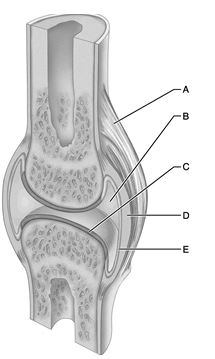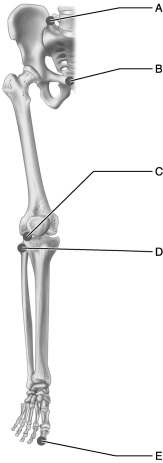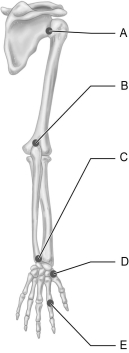A) A
B) B
C) C
D) D
E) E
Correct Answer

verified
Correct Answer
verified
Multiple Choice
A joint capsule (articular capsule) has two layers. The function of the capsule's internal layer is to
A) strengthen the joint against tension.
B) produce synovial fluid.
C) contain all of the nerves and blood vessels of the joint.
D) act as a meniscus.
Correct Answer

verified
Correct Answer
verified
Multiple Choice
Gliding movements occur between all these joints except
A) adjacent carpals.
B) adjacent phalanges.
C) articular processes of vertebrae.
D) temporomandibular joints.
Correct Answer

verified
Correct Answer
verified
Short Answer
Baseball players often damage the ________ cuff at the shoulder region.
Correct Answer

verified
Correct Answer
verified
Multiple Choice
An example of a diarthrotic synchondrosis
A) is the epiphyseal plate.
B) is the intertarsal joint.
C) is the knee.
D) does not exist.
Correct Answer

verified
Correct Answer
verified
Multiple Choice
Which of these joints is a hinge joint, primarily involved in articulation with the ulna rather than the radius?
A) elbow joint
B) shoulder joint
C) sternoclavicular joint
D) hip joint
E) ankle joint
Correct Answer

verified
Correct Answer
verified
Multiple Choice
Which of these statements about menisci is False?
A) They contain fibrocartilage.
B) They are found in all synovial joints.
C) They can divide the joint cavity.
D) They can allow two movements at a single joint.
Correct Answer

verified
Correct Answer
verified
Short Answer
To ________ the foot, move the plantar surface laterally.
Correct Answer

verified
Correct Answer
verified
Multiple Choice
 Figure 9.1
Use the diagram above to answer the following questions.
-Which letter indicates the fibrous layer of the articular capsule of this synovial joint?
Figure 9.1
Use the diagram above to answer the following questions.
-Which letter indicates the fibrous layer of the articular capsule of this synovial joint?
A) A
B) B
C) C
D) D
E) E
Correct Answer

verified
Correct Answer
verified
Multiple Choice
Articular cartilages are found both in symphyses and in
A) sutures.
B) synovial joints.
C) synchondroses.
D) syndesmoses.
Correct Answer

verified
Correct Answer
verified
Multiple Choice
Which of these joints is stabilized by an iliofemoral ligament, a pubofemoral ligament, and an ischiofemoral ligament?
A) elbow joint
B) shoulder joint
C) sternoclavicular joint
D) hip joint
E) ankle joint
Correct Answer

verified
Correct Answer
verified
Multiple Choice
 Figure 9.2
Use the diagram above to answer the following questions.
-Which letter indicates a cartilaginous, amphiarthrotic, symphysis type of joint?
Figure 9.2
Use the diagram above to answer the following questions.
-Which letter indicates a cartilaginous, amphiarthrotic, symphysis type of joint?
A) A
B) B
C) C
D) D
E) E
Correct Answer

verified
Correct Answer
verified
Multiple Choice
Which of these joints allows for dorsiflexion and plantar flexion?
A) elbow joint
B) shoulder joint
C) sternoclavicular joint
D) hip joint
E) ankle joint
Correct Answer

verified
Correct Answer
verified
Multiple Choice
Expansion of the rib cage during inhalation is possible because the costovertebral joints are
A) amphiarthrotic.
B) biaxial.
C) synchondroses.
D) synovial.
Correct Answer

verified
Correct Answer
verified
Multiple Choice
The main function of synovial fluid is
A) cooling.
B) nourishing bone.
C) removing metabolic wastes.
D) lubrication.
Correct Answer

verified
Correct Answer
verified
True/False
The term synovial joint contains the root word ov, referring to ovum, or egg, because the synovial fluid is viscous like the white of the egg.
Correct Answer

verified
Correct Answer
verified
True/False
A tendon sheath is an elongated membranous sac filled with synovial fluid that wraps around a tendon.
Correct Answer

verified
Correct Answer
verified
Multiple Choice
Student's elbow is an example of
A) tendonitis.
B) bursitis.
C) osteoarthritis.
D) gout.
Correct Answer

verified
Correct Answer
verified
Short Answer
This is a type of arthritis in which crystals of urate accumulate in the synovial membranes.
Correct Answer

verified
gout (gout...View Answer
Show Answer
Correct Answer
verified
View Answer
Multiple Choice
 Figure 9.3
Use the diagram above to answer the following questions.
-Which letter indicates a synovial, diarthrotic, hinge type of joint?
Figure 9.3
Use the diagram above to answer the following questions.
-Which letter indicates a synovial, diarthrotic, hinge type of joint?
A) A
B) B
C) C
D) D
E) E
Correct Answer

verified
Correct Answer
verified
Showing 41 - 60 of 110
Related Exams